Editor’s Note: This article was originally published in Overland Journal, Fall 2017
Considering two-thirds of our planet is covered by water, it’s heartbreaking to think that this year 3.1 percent of all global deaths will be attributed to contaminated drinking water. As Samuel Taylor Coleridge opined in his epic poem, “The Rime of the Ancient Mariner,” “Water, water everywhere, nor any drop to drink.” Words penned over 2 centuries ago, they still ring true today. Even if you’re surrounded by H2O, you still have to make it safe to consume.
For the modern traveler, waterborne illnesses are of genuine concern. If you’re lucky enough to ingest a relatively benign bug, your mild discomfort might be short lived. Gulp down something more sinister and it could cost you two coins for the ferryman. The first step in staying healthy, and alive, is understanding what lurks unseen in your water.
In North America, common waterborne pathogens typically include bacteria and protozoa. The most ubiquitous bacterium are E. coli and salmonella, the gastrointestinal evildoers frequently associated with bad burritos hawked at chain restaurants. More widespread in the wilderness are protozoa, the relatively large microorganisms which cause sicknesses with disarming monikers like beaver fever. The most well known in this category are giardia and cryptosporidium, the latter particularly nasty given its resistance to chemical treatments. For decades, the best ways to protect against protozoa and bacteria were to boil them to death or mechanically remove them with a filter.
The third class of villain is the virus. Those of us in North America have few waterborne viruses to contend with, but it is good to know what they are and how they can be contracted. Norovirus and rotavirus can cause severe and lasting flulike symptoms, but are more likely to ruin your cruise ship vacation than your backwoods campout. On a more worldwide basis, viruses like Hepatitis A are of growing concern. It’s also helpful to know that viruses are generally species-specific, meaning they can only transfer from one human to another. As such, in less-developed countries, the threat of drinking in a virus is more likely where water and human waste intermix.
Since the thought of playing host to illness-causing microbes is such a disturbing concept, it’s easy to overlook the less creepy but equally harmful contaminants in your water. We also have to worry about pesticides, herbicides, heavy metals, and sometimes a literal morass of manufactured chemicals generated by agriculture and industry. As each of these threats have been made known, scientists have done their best to invent new ways to mitigate them.
FILTERS AND PURIFIERS
There are two distinct categories of water treatment systems, one not particularly better than the other. A filter employs technologies to mechanically remove matter and microbes from the water, but to no specific level of efficacy. In the United States, there are no regulations to stipulate what can be sold as a filter, meaning a bandanna draped over a tin cup qualifies.
A purifier, on the other hand, must meet specific criteria established under the EPA “Guide Standard and Protocol for Testing Microbiological Water Purifiers.” In addition to disinfecting water of bacteria and protozoa, a purifier must also treat against viruses. To that end, a number of methods can be relied on, including microfiltration, ultraviolet light, and chemicals to neutralize biological elements. In some cases, the organisms in the water may not be killed outright, but instead rendered incapable of reproduction and in turn, inactive. Oddly enough, purified water can still retain high amounts of sediment, particulates, and taste absolutely vile—as long as it does not contain microbes capable of causing illness.
CONSIDERATIONS FOR WATER TREATMENT SOLUTIONS
Where you travel and what nefarious creatures are most likely swimming in your glass will determine if you are best served with a filter or a purifier. Beyond that are other variables to factor into your final selection like group size, water turbidity, portability, field serviceability, and ease of use.
For most travelers, group size will narrow the selection process quickly. A system designed for individual use will unlikely process the volume of water required by a team of people. Along those lines, some travel routes will offer near endless chances to refill water supplies, while others may only afford infrequent opportunities. The need to process large quantities of water in one session can better suit a particular system over another.
International travelers are often more likely to encounter clear and palatable water, but need to ensure it is free of microbes. A UV light pen might permit the ability to quickly purify just one glass of water while seated at a restaurant table, not something easily achieved with a large pump mechanism. Conversely, travelers in the desert may only get one chance every few days to filter water from stagnant pools heavily discolored by rotting plants and darkened with thick silt. Those situations are ideally suited for a high volume filtration mechanism, particularly one which can be cleaned quickly and returned to service.
MSR
GUARDIAN PURIFIER | EDITOR’S CHOICE AWARD
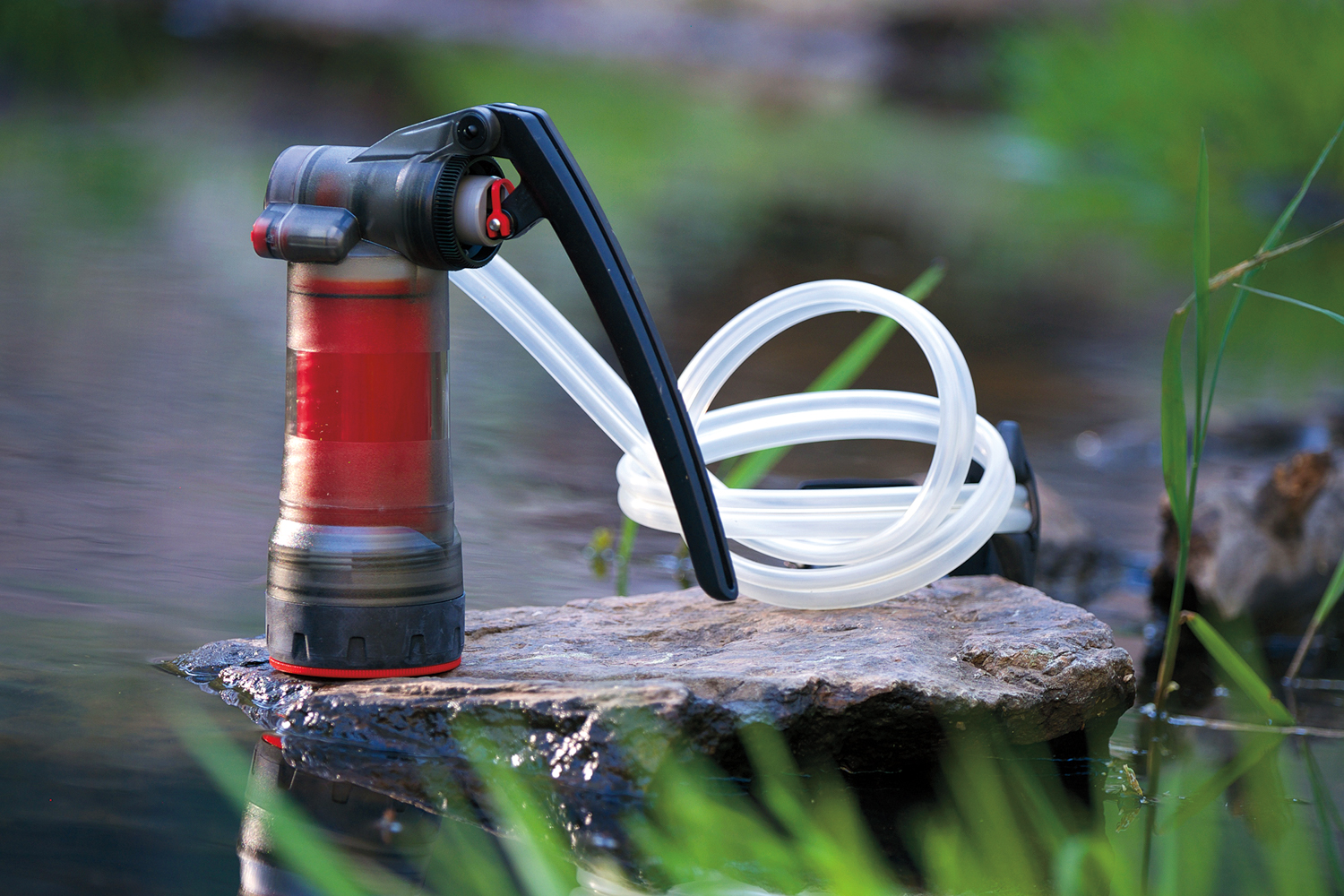
PROS
Virus protection
The only pump with NSF P248 certification
Self-cleaning
Fast flow rate
CONS
Price
Weight
Arguably the most advanced purifier of its kind, the Guardian was produced in collaboration with the U.S. military and is the only such purifier to meet their demanding NSF P248 testing standard. Proven to remove protozoa, bacteria, and viruses, it surpassed the government’s requirements for processing “worst case” water conditions which also included high degrees of sediment with elevated pH levels. In short, the most unpleasant swamp water the Pentagon could envisage. Because combat zones are tough on gear, the Guardian also survived rigorous drop and freeze tests.
Perhaps the most impressive aspect of the Guardian’s design, aside from its virus-fighting .02-micron, hollow-fiber filter element, is the pump’s ability to rapidly process up to 2.5 liters per minute. The multi-pivoted lever mechanism produces maximum volume with minimal physical effort. Best of all, the pumping action redirects a portion of the purified water flow back through to the filter element to clean it with each stroke. Even in the worst water conditions, the Guardian never seems to slow, nor does the pumping resistance increase.
At a shade over 1 pound, the Guardian is not ultralight, nor does it pack into a tiny bundle, but it provides unprecedented speed and filtering efficacy. Deployed and primed in a matter of seconds, it is an ideal solution for producing large quantities of water from less than pleasant water sources. With a 10,000-liter maximum capacity, it is perfectly suited for prolonged expedition travel, and the entire assembly can be field maintained without tools.
$350 | MSRGEAR.COM | 800-531-9531
KATADYN
HIKER PRO
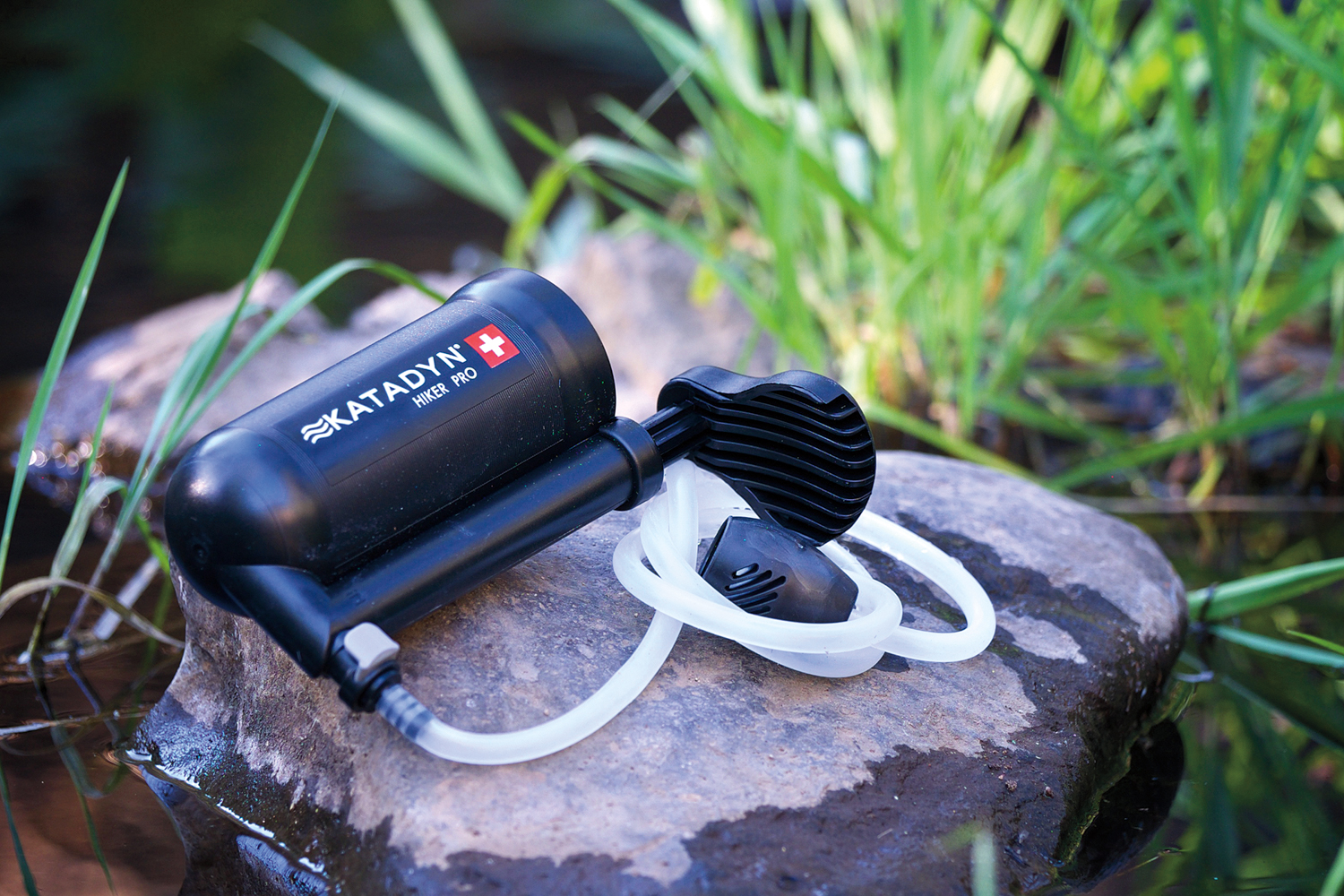
PROS
Simple design
Proven reputation
Easy to clean
Difficult to clog
CONS
Slow
Can’t direct mount to bottles
No virus protection
The Hiker Pro is one of the most proven filtration systems on the market; my own unit is still going strong after 20 years of regular use. The key to its proficiency is the unique .2-micron, glass-fiber filter element constructed with deep pleats for maximum surface area. Wrapped around the filter is an additional removable membrane designed to prevent heavy sediment from embedding in the glass fibers. The result is a filter element which is slow to clog, but should it begin to, can be quickly removed from the pump assembly, rinsed, reinstalled, and returned to optimal output in minutes and without the use of tools.
Supplying the water flow is a simple mechanism reminiscent of a miniature bicycle pump. With only one moving part, the Hiker has just seven primary components including the two hoses. The input hose is fitted with a weighted pre-filter and an adjustable float; the output hose attaches to the pump with a standard quick connect clip which can be joined to most hydration reservoirs for a convenient direct refill. Although it isn’t the fastest filter at 1 liter per minute, the effort required to produce that flow rate is minimal. The kit includes an adapter for most standard bottle openings and a zippered storage sack.
Ideal for individual and small group use, the Hiker Pro is well suited for situations where water turbidity is a principal challenge. A carbon-impregnated layer within the filter element helps improve the flavor of water otherwise made foul by decaying vegetation––or worse. Tried and true, the Hiker is a safe bet for anyone not in need of virus protection.
$85 | KATADYN.COM | 800-755-6701
MSR
MINIWORKS EX MICROFILTER
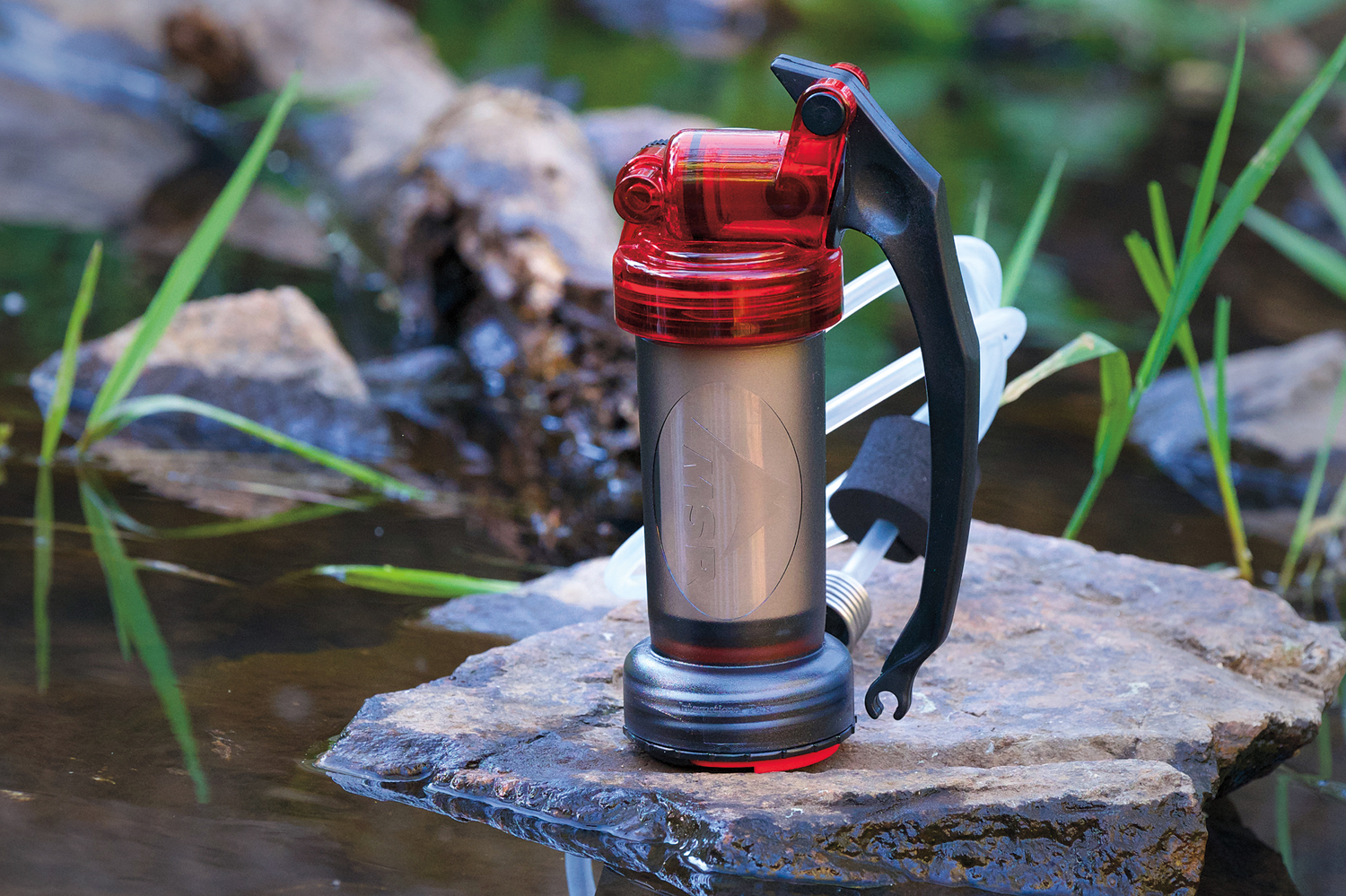
PROS
Easy to clean
Durable filter element
Effortless pumping action
CONS
Slow
Fragile filter element
Large size
No virus protection
The MiniWorks can trace its origins to 1990, and in the years since has been the king of the mud puddle. Known throughout the backcountry as the go-to for water sources choked with sediment, MSR’s Marathon EX carbon/ceramic element has a legendary reputation for reliability. Made in small batches and individually tested at their facility in Seattle, Washington, the filter within the MiniWorks is not only slow to clog, it can be removed, rinsed, and returned to operation in under a minute. The large pump lever actuates MSR’s proprietary AirSpring Accumulator which decreases the effort required to produce a 1-liter-per-minute flow rate.
Like the Guardian, which mimics the proven shape of the MiniWorks, the pump foregoes an output hose in favor of a bottle mount for direct-to-container filtering. This eliminates the need for a third hand, but most importantly reduces the risk of contaminating the clean output hose by inadvertently dropping it in the dirty water source. Like all MSR water systems, the MiniWorks can be completely field serviced without tools, and the filter element can produce up to 2,000 liters of water in a best-case scenario. The embedded carbon layer in the filter thwarts the funky smell and flavor that plagues many water sources, and the entire assembly fits in a small zippered stuff sack for transport.
Over the years I have pitted the MiniWorks EX against impossibly murky cow tanks, sour smelling bogs, and gooey ponds and it has never failed to deliver clean water. There have been ample times when it needed a thorough rinse with every liter, but with a little patience and persistence it always gets the job done and water in my bottles. If the MiniWorks has a weakness, it’s that it doesn’t like to be dropped or frozen.
$90 | MSRGEAR.COM | 800-531-9531
SAWYER
SQUEEZE WATER FILTRATION SYSTEM | VALUE AWARD
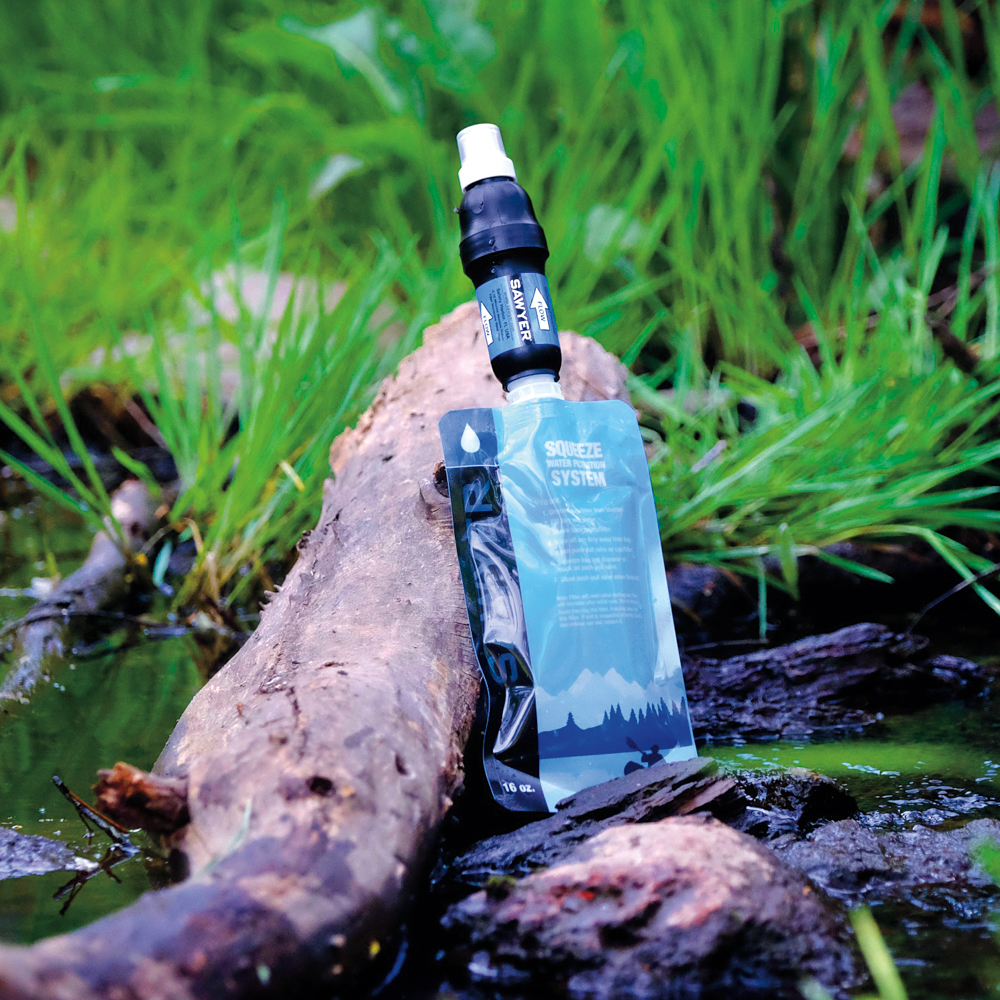
PROS
Excellent value
Light
Multiple applications
CONS
Hard to drink from
Must carry backflush syringe
Doesn’t improve taste
No virus protection
A relatively new player in the filtration game, Sawyer’s Squeeze has become one of the more popular products in their diverse catalog. Using hollow-fiber technology similar to that used by MSR and other manufacturers, the Squeeze removes protozoa, bacteria, and particulates down to .1 microns, which is not quite small enough to remove viruses. Available in a variety of options, our system came with two 64-ounce soft bottles and one 16-ounce bottle. To use the Squeeze, simply fill a bottle with dirty water, thread the filtration cartridge to the cap, and as the name would imply, squeeze the container. Drink directly from the nozzle or dispense the clean water into an additional vessel.
As I have experienced with most hollow-fiber filter elements, save for the self-cleaning Guardian, the Squeeze is susceptible to clogging even in mildly turbid water. To remedy a slightly fouled filter, the kit includes a high-volume syringe which is used to forcefully backflush the cartridge. Even in the worst water conditions, a few thorough rinses got the Squeeze back up to speed, but never quite to the claimed 2-liter-per minute flow rate.
Weighing in at only 3.5 ounces, the primary advantage to the Sawyer system is actually its versatility. The filter cartridge can be deployed as a gravity-fed unit for hands-free water processing or plugged in-line on a hydration drink system. When it was first launched, Sawyer claimed a single filter could process up to a million gallons, but they have since tiptoed away from that number. As is true for most filters, poor water quality will eventually cause a filter’s early demise, but so far my Squeeze has processed a lot of water with no signs of slowing.
$50 | SAWYER.COM | 800-356-7811
PLATYPUS
GRAVITYWORKS 2.0L WATER FILTRATION SYSTEM, COMPLETE KIT

PROS
Ease of use
Simple backflush procedure
Lightweight
CONS
Complex setup
Can’t handle heavy sediment
No virus protection
As proficient as new pump designs are, nothing is easier than letting nature do all of the hard work for you. Redesigned for 2017, the Platypus GravityWorks represents the cutting edge in gravity-powered filtration technology and carries forth on an already superb product. Central to this system is a .2-micron, hollow-fiber filter element capable of removing particulates, bacteria, and protozoa at a rate of 1.5 liters per minute. The kit includes two virtually indestructible Platypus 2-liter, soft-sided containers and an assortment of bottle adapters for hands-free filtering. Using the system is as simple as filling the clearly labeled dirty reservoir with untreated water and elevating it above the container designated for clean water. Gravity does the rest.
Sediment is the foe of any filter, and gravity systems are typically the most susceptible to clogging, as water is not mechanically forced through the filter element. To reduce the amount of silt and debris entering the hollow-fiber filter, the output hose on the dirty water reservoir is located just above the lower edge of the container to allow particulates to settle at the bottom. This eliminates the need to decant silty water in a separate container. Should the filter begin to slow, backflushing is simple and only involves inverting the two bags to reverse the flow. In as little as 4 seconds clean water is pushed through the filter dislodging most blockages.
At only 10.9 ounces with a compact packed size, the GravityWorks is an ideal solution for any application where weight is a consideration, as well as the need to process larger volumes of water in a single session.
$110 | PLATY.COM | 800-531-9531
KATADYN
BASE CAMP PRO 10L
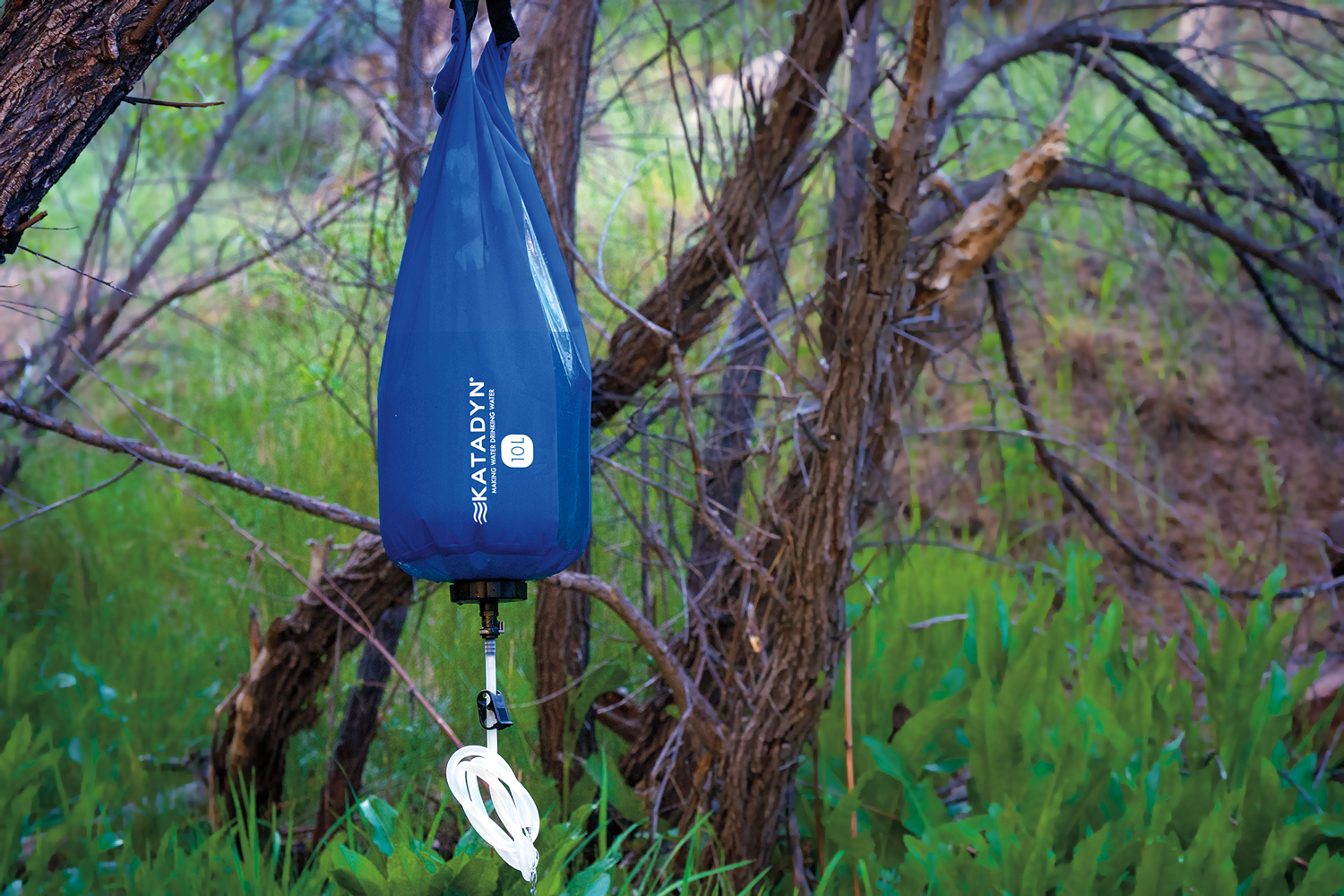
PROS
High capacity reservoir
Easy to clean
Optional shower accessory
CONS
Complex setup
No virus protection
The largest of two gravity systems in the Katadyn lineup, the Base Camp is best suited for small to big groups requiring high volumes of clean water. To achieve that goal, every aspect of the system including the massive 10-liter reservoir was carefully engineered to be fast, reliable, and convenient.
Threaded within the base of the collapsible container is the company’s own pleated glass-fiber Ultra Flow Filter protected by an outer pre-filter membrane. Backflushing filters is convenient but not always as effective as a proper scrub, and the outer membrane can be removed, rinsed, and reinstalled in minutes, returning the filter to its original 2-liter-per-minute flow rate. The fastest of any gravity filter on the market, it removes bacteria, protozoa, and particulates smaller than .2 microns. Helping to further reduce clogging, the filter element rests above a recessed sediment trap allowing dirty water to be decanted in the main bag prior to filtering.
Below the reservoir, a quick-connect attachment port permits direct filling to hydration tanks and accepts Katadyn’s optional shower attachment for maximum utility. Other convenient features include a large nylon strap for a comfortable carry and a transparent window to view water levels and inspect any sediment buildup on the filter membrane. Every aspect of the Base Camp was engineered to keep large quantities of water flowing regardless of turbidity, and after extensive tests with the unit pitted against grimy desert water, it proved up to the task. Katadyn claims they were the first to bring a gravity filtration system to market and the Base Camp demonstrates their proficiency within the category.
$100 | KATADYN.COM | 800-755-6701
PLATYPUS
META BOTTLE + MICROFILTER

PROS
Ease of use
Portability
Value
CONS
No carbon filter for improved taste
No virus protection
Another fresh entry in the personal filtration game, the Meta Bottle is Platypus’ first foray into the almost traditional bottle market after being in the soft-sided water container business for over 20 years. Unlike other soft bottles, the Meta has enough structure to stand on its own and slips into pockets and holders better than true soft-sided bottles. The semisoft lower half can collapse within the rigid upper section for compact transport when empty (filter element removed) and the top cap includes a drinkthrough port with protective lid.
Filtering water is as simple as filling the lower half with untreated water, threading on the lid, and squeezing the bottle while drinking. Clean water is delivered at a 2-liter-per minute rate straight to your thirsty mouth without the need to suck water or use a second hand. The filter employs MSR’s hollow- fiber microfilter technology which meets EPA and NFS standards to remove all the common biological pathogens with the exception of viruses. A single filter element can process up to 1,000 liters and backflushing the system requires nothing more than a few vigorous shakes. This is an ideal travel solution for personal use as well as an excellent emergency backup filter.
$50 | PLATY.COM | 800-531-9531
STERIPEN
QUANTUM RAPID PURIFICATION SYSTEM
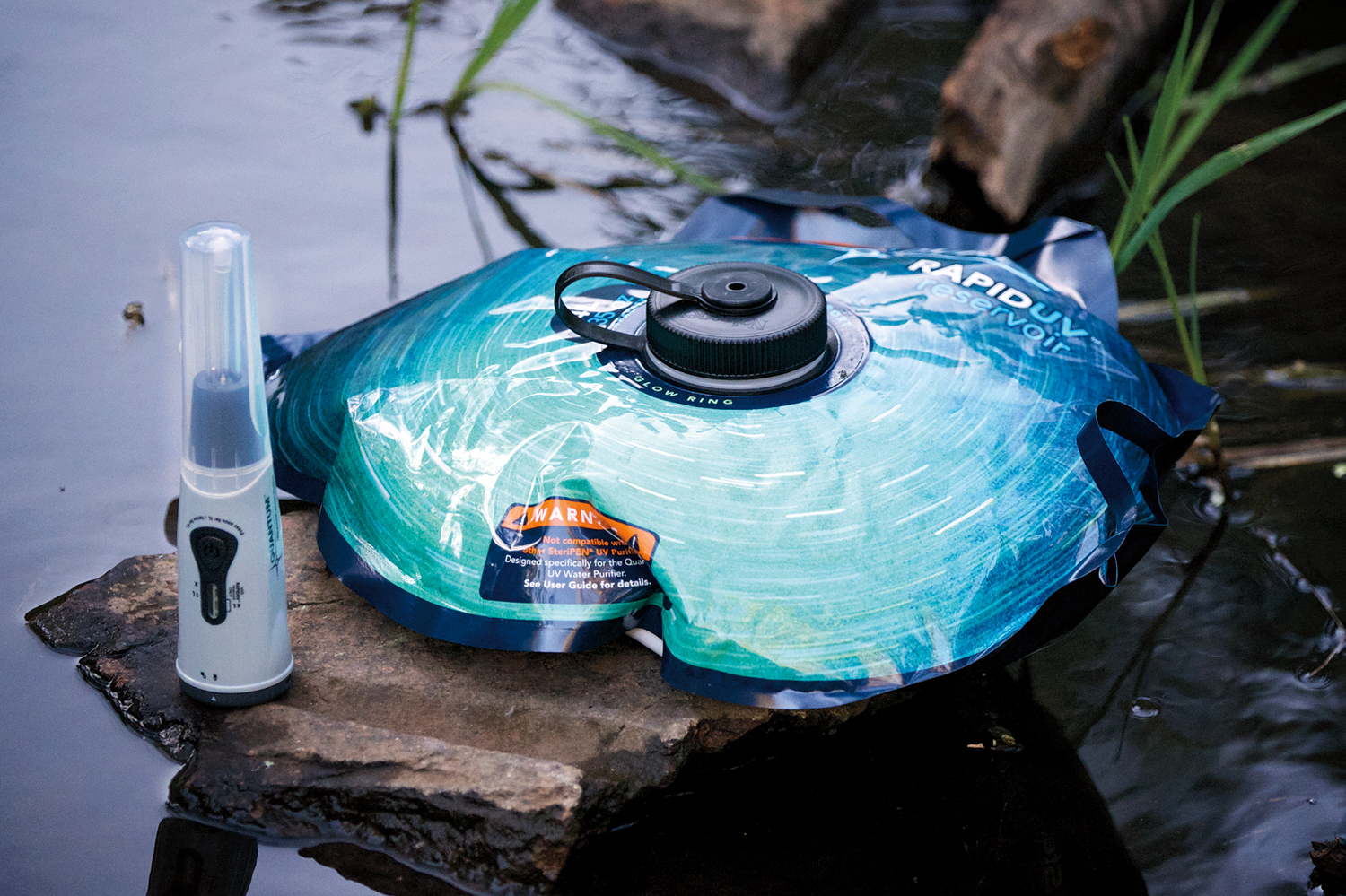
PROS
Virus protection
Portability
Rapid purification
12,000-liter max capacity
CONS
Does not remove particulates
Does not improve flavor
Fragile
Roughly 6 years ago we funded an elaborate and costly lab test which included a SteriPen and we flunked it. I found the results concerning as I had consumed untold gallons of water using the device in parts of the world where water quality is not just poor, but known to harbor high concentrations of dangerous microbes. I did extensive research over the course of the last year and read through dozens of third-party tests spanning more than a decade. In the absence of any results that said otherwise, I deduced the SteriPen UV technology works as advertised and has legitimately earned its certification as an effective purifier. I continue to use the SteriPen on outings around the globe, but also understand it has limitations. It has to be used precisely so as to not invite contamination.
For the traveler, the SteriPen has unrivaled benefits, portability and ease of use chief among them. It’s just as easy to treat a glass of water at a café in Mombassa as it is a bottle of water from a mountain stream. It’s quick, push-button simple, and has the advantage of killing all microbes including viruses. If there is a downside, it is an inability to remove sediment or process large volumes of water with any speed. The latter issue has been addressed with SteriPen’s new Quantum Rapid system which can now treat 4 liters of water in just 150 seconds. Using their proprietary reservoir to optimize UV light transmission through the water, this is possibly the fastest purifier on the market.
The combination of the AA battery powered SteriPen and the new Quantum Rapid reservoir increases the utility of the UV light, making it ideal for international travel and at least some backcountry uses where water turbidity is less of an issue. If there is one parting note to mention with UV technology, it is that the efficacy of the system is dependent on the user and their ability to not contaminate their clean water during use.
$70 | STERIPEN.COM | 888-783-7473


